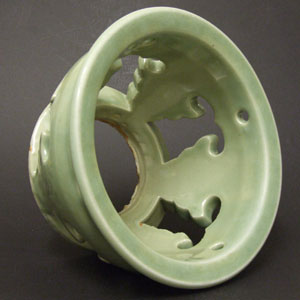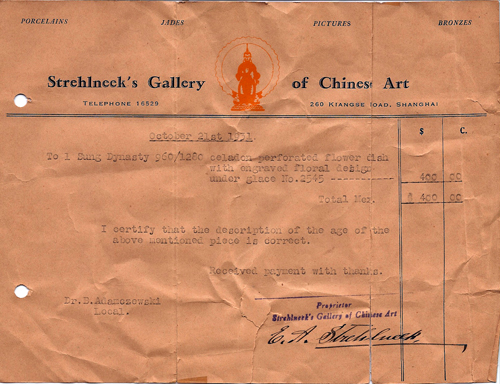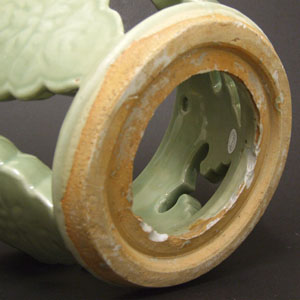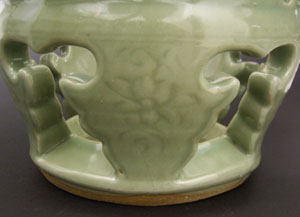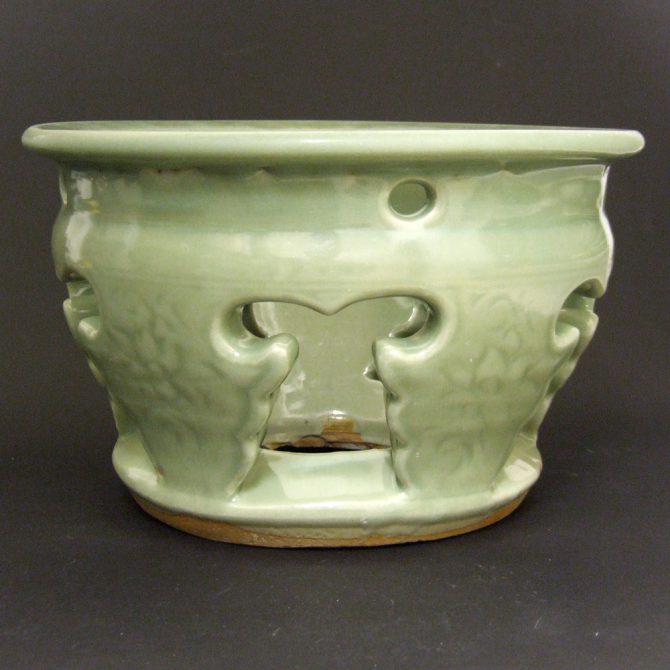
MING DYNASTY 1368 – 1644 Longquan Celadon Ware
A Ming Dynasty Longquan Celadon Ware Stand, Produced at the Longquan Kilns in Zhejiang Province. The Sides and Base are Cut-Out, the Body was Incised Prior to Glazing. Early Ming Dynasty Late 14th or 15th Century.
SOLD
- Condition
- A crack to the base ring next to one of the uprights c.55 mm long, it extends about half the way around the ring. Some chipping to the lower part of the inner ring, some of which were cloearly done during the firing process.
- Size
- Diameter (of the top) : 25.8 cm (10 inches) Height : 16.2 cm (6 1/3 inches).
- Provenance
- Strehlneek`s Gallery of Chinese Art, 206 Kiangse Road, Shanghai, October 21st 1931. Described as "Sung Dynasty 960/1280 celadon perforated flower dish with engraved floral design under the glace No.2545, $ 400". The purchaser was a Dr Adamczewski, his address was described as "local". Original invoice.
- Stock number
- 22413
- References
- For a Ming Celadon stand of this type see : Chinese Ceramics in the Topkapi Saray Museum Istanbul, A Complete Catalogue, Volume 1, Yuan and Ming Dynasty Celadon Wares (Regina Krahl, Published in association with the Directorate of the Topkapi Saray Museum by Sotheby`s Publications 1986) Page 372 Plate 542. For a further Ming celadon Stand See : Ming Ceramics in The British Museum (Jessica Harrison-Hall,The British Museum Press,2001) Page 495 Item 16:85. For another Ming stand see our `Sold Items` stock number 20201
Information
Celadon Stands :
A number of these Ming Celadon stands are in museums and have been published. One is in the Topkapi Saray Museum in Istanbul, in London one can be found in the British Museum and a further example can be seen at the Victoria and Albert Museum. Franks suggested that these thickly potted Celadon stands were made to support a bowl, but Jessica Harrison-Hall and Regina Krahl suggest it could equally well have been used to support a baluster vase. Harrison-Hall in Ming Ceramics in The British Museum shows their Celadon stand with the unglazed rim upper most, so that the smaller unglazed rim can support a vase or bowl. This looks wrong to me, I feel the object should be the other way around, as illustrated here. The example at the Victoria and Albert Museum is displayed as ours, but has a dish on top which they have used to display fruit. This is I think, a more plausible explanation of their use.
Celadon Ware:
Celadon is a term used to describe several types of Chinese stoneware and porcelain, as well a ceramics from other countries, notably from Korea and Japan. The term is a imprecise one, applying to various types of green glazed ceramics, but not all ceramics with green glazes, there are several wares that have a green glaze that are not refereed to as celadon. For example Green Jun and Ge Ware. For this reason there has been a move to try to clarify the situation by using the term `Green Ware`. But for now Celadon is a more familiar and therefore useful term. The origins of the term Celadon are not clear, one theory is that the term first appeared in France in the 17th century and that it is named after the shepherd Celadon in Honoré d`Urfé`s French pastoral romance, L`Astrée (1627), who wore pale green ribbons. (D`Urfe, in turn, borrowed his character from Ovid`s Metamorphoses.) Another theory is that the term is a corruption of the name of Saladin, the Ayyubid Sultan, who in 1171 sent forty pieces of the ceramic to Nur ad-Din, Sultan of Syria. Yet a third theory is that the word derives from the Sanskrit sila and dhara, which mean "stone" and "green" respectively. Celadon ware originated in Zhejiang Province in the Eastern Han Dynasty, however green monochrome glazes can be found on stoneware much before that date. Zhejiang is were the famous Longquan Celadons were made but Celadon wares were also produced at Jiangsu, Hubei, Hunan and Jiangxi. The production of Celadon Ware required a reducing atmosphere of around 1300 degrees C., the colouring agent was a mixture of iron oxide and titanium. The glaze was applied very thickly, and was full of tiny bubbles which defuse the light giving the appearance of richness and softness.
